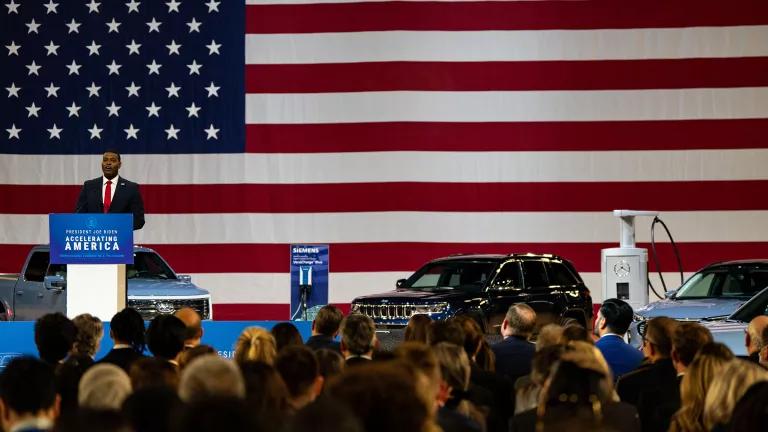Agreement Proposed to Electrify San Diego’s Buses and Trucks

One of Southern California’s largest utilities, San Diego Gas & Electric (SDG&E), would deploy charging infrastructure to support around 6,000 electric buses, trucks, and other medium and heavy-duty vehicles—and an electric school bus vehicle-to-grid (“V2G”) pilot project—under a proposal filed today at the California Public Utilities Commission.
If approved, the proposed deal would modify SDG&E's original proposal (filed in January 2018) to align with, and build upon, medium- and heavy-duty vehicle electrification programs the commission approved for California’s other large investor-owned utilities, Pacific Gas and Electric (PG&E) and Southern California Edison (SCE) in May 2018.
Together, these programs will help California meet its goal of accelerating the transition away from diesel engines, reducing dependence on petroleum, improving local air quality, and reducing emissions of greenhouse gases. PG&E and SCE’s authorized medium and heavy-duty programs have a combined budget of $592 million. If approved, the settlement proposed for SDG&E would authorize a $107 million program. The combination would be by far the largest investment by the electric industry in the US to help replace diesel trucks, buses, forklifts, cranes, and other large vehicles and heavy equipment with zero-emission technology.
The utility programs will complement the $290 million investment in zero-emission medium and heavy-duty vehicles authorized by the California Air Resources Board earlier this year, pursuant to the Volkswagen (VW) Environmental Mitigation Trust. The utilities’ provision of the electrical equipment needed to charge zero-emission vehicles purchased with the assistance of VW funds will allow the state to stretch its resources further, buying down the cost of more vehicles and increasing the air quality benefits as a result.
Just like in trial courts, if consensus can be reached between interested parties at the Public Utilities Commission, those parties can propose a settlement agreement that, if approved by the court (or in this case, the commission), avoids the need for a long and adversarial process.
The settlement proposed in the SDG&E case enjoys broad support from a diverse group of consumer, environmental, and equity advocates; organized labor, EV charging companies, and other organizations including: Natural Resources Defense Council, California Public Advocates (formerly the “Office of Ratepayer Advocates”), Environmental Defense Fund, Union of Concerned Scientists, Coalition of California Utility Employees, CalSTART, Small Business Utility Advocates, Electric Motor Werks, Siemens, ChargePoint, Chanje Energy, Plug In America, Earthjustice on behalf of Center for Community Action and Environmental Justice and East Yard Communities for Environmental Justice, and Sierra Club.
Electrifying medium and heavy-duty vehicles will provide much-needed pollution relief to low-income communities and communities of color that often live near freeways, ports, railyards, and other facilities that generate significant levels of localized engine exhaust. The proposed settlement requires that a minimum of 30 percent of all charging stations deployed in program be located in such communities, providing cleaner air where it’s most needed.
Diesel-powered medium and heavy-duty vehicles pose a triple threat for the health of local communities because:
- Diesel emissions are toxic and harm communities closest to the source of the pollution, leading to premature death and other devastating health problems, including asthma and respiratory issues, pregnancy complications and adverse reproductive outcomes, cardiac and vascular impairments, and heightened cancer risk;
- Diesel engines also emit large quantities of nitrogen oxide (NOx) pollution, which contributes to regional air pollution problems like fine particulate matter and ozone (i.e. smog); and
- Diesel vehicles generate GHG emissions that contribute to global climate change, which exacerbates local air quality issues through various means; climate-driven increases in ozone can cause premature deaths, hospital visits, lost school days, and acute respiratory symptoms, and wildfires made more frequent and more severe by climate change further increase emissions of particulate matter and ozone precursors, resulting in additional adverse local health outcomes.
SDG&E’s proposed program would accelerate the transition to zero-emission vehicles and help address the triple threat posed by diesel pollution.
The program would also implement a vehicle-to-grid or “V2G” pilot for electric school buses that would address a particularly vulnerable population—children, whose growing lungs are exposed to dangerous levels of diesel pollution in the cabins of the buses that take them to and from school.
The “V2G” aspect of that pilot would charge the big batteries in those school buses when renewable energy is abundant, and, not only use it to drive kids around town, but put it back on the grid when electricity is most needed. That can lower the cost of managing a grid with large amounts of variable sources of electricity generation like wind and solar, and it can provide a valuable revenue stream to fleet managers and school districts making it more attractive to invest in electric school buses.
Together with the PG&E and SCE programs, on top of existing electrification programs for light-duty passenger vehicles, the proposed program would take California one step closer to the goal of accelerating “widespread transportation electrification” set out by SB 350 (De León, 2015). The program would also help to meet SB 350’s directive to ensure that communities historically exposed to a disproportionate share of air pollution realize the benefits of zero-emission vehicles.
If approved by the commission, SDG&E’s program would fill a critical gap in the San Diego region, expanding access to cleaner air and cleaner transportation, while supporting a cleaner electrical grid.



